|
Never Too Old to Dream
By Margaret
G. Huff
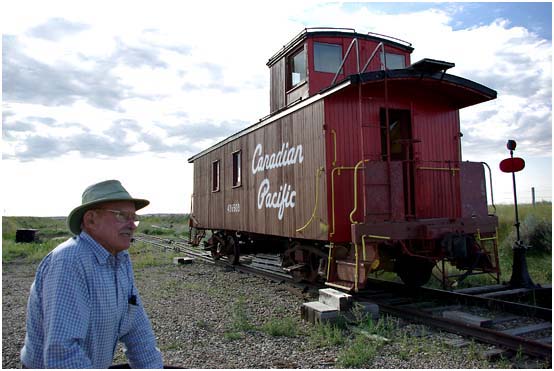
Carl Goddard and his Canadian Pacific
Railway caboose at Manyberries, Alberta - Margaret Huff.
Carl and Joyce Goddard will be coming home soon... home to the first crocuses of a southern
Alberta prairie spring, the slow release of winter's grip on the broad sweep of the land and their own personal view of the Sweetgrass
Hills.
For almost 16 years, ever since early 1995, Carl Goddard has rolled up his sleeves every spring and continued work on his
"project". But this year will mark the end of the project for him. Time and worn artificial hips have cut short his dream but,
with typical optimism, Carl hopes he can find someone who will carry on and complete what he began.
"There has to be someone out there as crazy as Joyce and me who'll pick up where I have to leave off and finish this thing," says
Carl Goddard, as he talks about the project that has consumed his time and energy every summer for many years.
In the 1960s and 70s, the pair had been next-door neighbours in Thompson, Manitoba. Each was married to someone else and busy raising a
family. A geologist, Carl had a wife, a son, and three daughters. Joyce, an elementary school teacher, was raising two daughters and four
sons with her husband, who worked with Carl at the mining complex.
Two decades later found both of them living in Winnipeg. Both were alone, their children launched, and retirement years looming. They
renewed a casual friendship and time took them from companionship, to love, and eventually to marriage.
| |
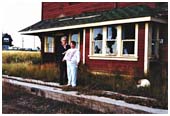
Joyce Goddard and Betty
Bohnet - Carl Goddard.
|
British-born Joyce owned a 300-year-old stone cottage on the Isle of Wight and she and Carl
established a pattern of spending the worst part of the Canadian winter there and summering in Winnipeg. Their children and grandchildren
had scattered throughout North America and Europe so they also traveled quite a bit to keep tabs on their broods. In the summer of 1991, a
road trip brought the pair to Edmonton and Calgary, Alberta.
Knowing they were history buffs, Carl's daughter Patti, who lived in Calgary, suggested they avoid the monotony of the Trans-Canada Highway
on the way home by following the Alberta portion of the Redcoat Trail instead.
The Redcoat Trail is a route that stretches from the location of Fort Dufferin, near Emerson, Manitoba, through Saskatchewan, and ends at
Fort Macleod, Alberta. It roughly follows in the hoof prints of the great march west made by the newly-formed Northwest Mounted Police
(NWMP) in 1874.
Carl and Joyce's Trek East
| |
The Redcoat's
Trek West
The boundary between Canada and the United States was established between 1872 and 1874, but whiskey traders from the United States
paid little attention to the new border. To establish its sovereignty over the western Canadian territories, the government was eager
to survey and settle the west, but there were many reports of lawlessness. In 1873, Canada's first prime minister, Sir John A.
Macdonald ordered Commissioner George French and Assistant Commissioner James F. Macleod to recruit a constabulary, and name it the
Northwest Mounted Police (NWMP).
This force was tasked with entrenching Canadian law in the 300,000 square mile area, beginning by suppressing the whiskey trade
centered around Fort Whoop-Up, said to be near the junction of the Belly and Bow rivers in present-day Alberta. The first task was
getting there.
The trek west began on the parade ground at Fort Dufferin in early July of 1874. Outfitted in scarlet jackets, pillbox hats, white
gauntlets, black riding boots, and gray breeches, the Redcoats, as they became known, must have been an impressive sight.
The 275 men were divided into six divisions. Each division was mounted on matched horses. They rode smartly out of the fort, trailed
by a mile-and-a-half long column of 73 freight wagons and more than 100 Red River carts loaded with farm implements and supplies of
food and water for both men and animals. Twenty-five spare horses, a few spare oxen, and some field artillery were also part of the
column. The NWMP were ready for anything... anything except perhaps what the west was about to throw at them.
The prairie heat and insects were merciless during the day. Nights were cold and damp. Living conditions for man and beast were
unbearable. Before long supplies ran low. Any water the column managed to find was brackish or had been fouled by herds of buffalo.
Forage for the animals was scarce. Men become ill, horses and oxen died. Many of the men were on foot. As their tall black boots were
reduced to tatters, they managed to barter with area aboriginals for moccasins.
The force broke into smaller groups so each would have a better chance of finding the forage and water they needed. One group was
diverted to Fort Edmonton.
On 10 Sep 1874, the main contingent reached the junction of the Belly and Bow rivers, but found no sign of Fort Whoop-Up. Several
weeks later, with the help of a Metis guide named Jerry Potts, the fort was found at the junction of the Belly and St. Mary rivers. It
turned out to be a collection of three roofless huts that had been abandoned by the whiskey traders.
With winter coming, French and some of the men, returned to Fort Dufferin. Macleod, and 150 men, forged ahead, completing the trek
that became known as the Redcoat Trail. In the late fall of 1874, Macleod's party established winter quarters at what was to become
Fort Macleod. Their orders were to establish an outpost, shut down the whiskey trade, establish friendly relations with the aboriginal
people of the area, and entrench Canadian law.
The following spring, Macleod and his men built the fort that would serve as their center of operations. It was named for the
Assistant Commissioner. With great patience and understanding, Macleod soon earned the trust of the local Blackfoot tribes and the
small force was able to bring law and order to the area.
A year later a second fort was built northwest of the NWMP's first outpost. Macleod suggested it be named after Calgary House, a
castle on the Isle of Mull in Scotland. That second fort became the modern day city of Calgary, Alberta.
|
Intrigued by the history of the Red Coat Trail, Carl and Joyce said good-bye to Patti and began
their trek east. It was a trip that would change their lives. Carl pointed the car south onto Highway 2 as they left Calgary. They passed
through Nanton and a turn northeast onto Highway 3 took them to Fort Macleod, where a visit to the current fort and interpretive centre told
Carl and Joyce what they needed to know to enjoy their personal experience of the Redcoat Trail.
From Fort Macleod, the pair traveled through farmland made lush by the process of irrigation. If they had been on horseback, forage wouldn't
have been a problem, at least on this leg of their personal Redcoat Trail trek. What a difference 117 years had made.
Leaving Fort Macleod behind, Carl and Joyce headed east, retracing the path taken by the NWMP, but in reverse. They left Lethbridge
traveling southeast on Highway 4. At the small community of Stirling, Carl turned east onto Highway 61, a secondary highway that took them
through Wrentham, Conrad, Skiff, Legend, Foremost, Namiskam, Etzikom, Pakowki, and Orion. Small to almost nonexistent communities dreaming
in the warm Alberta sunshine.
By the time they sped by Orion, a community of about 10 souls, Carl and Joyce were ready for some refreshment. A long slow curve to the
southeast brought them into the hamlet of Manyberries.
"We arrived in Manyberries on a hot August afternoon and found a sleepy little hamlet with a wide, dusty main street, dominated by the
hotel with its saloon and a restaurant," said Carl. "We stopped for coffee."
Carl and Joyce got out of their car, stretching after their long drive. They approached the restaurant but found a note on its door that
told them it was closed due to lack of business but they could get coffee at the saloon.
Carl says the Manyberries saloon looked like something out of a western movie set. It was dark and cool. Deer and antelope heads were
mounted on the walls. Three tables were pulled together and a group of rancher types were gathered around them enjoying cold beers. When
Carl and Joyce pushed open the door, a stream of bright sunshine shot across the floor and every head in the place swiveled. Strangers in
Manyberries were a curiosity worth noting.
The saloon was quiet as they entered and made their way across the floor to the bar. The hotel manager, Betty Bohnet, poured coffee for them
and then poured one for herself and joined them. Gradually the ranchers returned to their conversation while Bohnet made her new customers
comfortable with friendly chat about the community. Something she said, or something in the appearance of the hamlet, the saloon, or its
beer-drinking patrons sparked a fascination for Carl and Joyce.
They finished the coffee and resumed their drive, pulling out of the hamlet past a dilapidated building, hunched down in a hollow at the end
of the main street. They didn't know it would be calling them back.
Crazy Project or Madcap Adventure?
| |
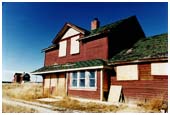
The CPR Manyberries station and
section house - 1995 Carl Goddard
|
The following July found Carl and Joyce, along with friends from England, in Manyberries enjoying
a small town rodeo and exploring the area. They discovered the abandoned and derelict Canadian Pacific Railway station hunched in the hollow
formed by the original track bed at the end of the main street.
Carl had long had a fascination for steam trains and was growing somewhat bored with retirement. He was fascinated by the 1917 vintage
Canadian Pacific Railway station, which operated until 17 Jul 1981. He later learned the station agent continued to live at the station
until 1988 and, after he and his family left, it was rented for about three years. The station was left to the elements and vandals when the
renter moved out. Chunks of plaster had fallen from the walls, and the cedar-shake roof was disintegrating.
Daylight lit the dismal rooms of the second-floor living quarters, as much coming through the roof and through the grimy windowpanes.
Carl ventured downstairs and found a flooded basement. He later learned that the water supply had not been turned off in 1991, when the
station was abandoned. During a cold snap in the early 1990s, someone noticed water pouring from the first floor windows and called the
County of Forty Mile. The water was turned off and the basement pumped out, but groundwater had been seeping in. Carl found 19 inches of
stinking, brackish, water in the basement.
In spite of its state of disrepair, Carl thought the building was a wonderful part of Alberta's heritage and kept saying someone should do
something to salvage and restore it before it was too late.
At the time, Joyce was having trouble with her landed immigrant status and needed an occupation to stay in Canada. As Carl poked around and
speculated about the building's square footage, Joyce said jokingly, "Now look at that, it's absolutely ruined. Why don't you buy it?
I could do bed and breakfasts for you to make a job for myself."
Carl's eyes lit up. He had a "project."
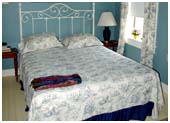
The B&B bedroom - Margaret
Huff.
|
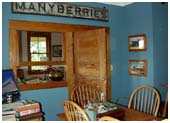
The ticket counter and dining
room - Margaret Huff.
|

The ticket counter and waiting
room - Margaret Huff.
|
Initial efforts to purchase the station failed because the Government of Alberta had put a hold on
all abandoned rail properties. In 1994, however, Canadian Pacific Railway contacted Carl and invited him to submit a bid on the property.
In January of 1995, Carl enlisted the help of his engineer son-in-law, Steve Price, and inspected the property more carefully. To say it was
in bad shape would be an understatement. Steve and his wife, Patti, were very concerned. They asked Carl if he was sure he knew what they
were getting into.
After discussing it with Joyce, Carl was undeterred. For better or worse, he wanted to take on the project. They submitted a bid, and took
possession on 24 Feb 1995.
More than a decade of hard work later, Joyce says, "Of course we didn't really know what we were taking on. When I encouraged Carl to
buy it and fix it up, I didn't know it would take until I was damn near 80."
On 25 Feb 1995 the work began. Carl's first priority was to get the water out of the basement. A vacuum pump truck sucked 11,000 gallons of
water out of the basement, leaving large chunks of ice. Even though he had undergone hip replacements, Carl lugged the ice up the narrow
wooden stairs and tipped them into a wheelbarrow so he could wheel them out of the house.
The station was of course not habitable so the pair rented a small house in Manyberries. Work on the interior and roof began in earnest in
March and by July Carl and Joyce were able to sleep at the station. They lived there year round for several years, devoting themselves to
the project that had become the centre of their lives.
"Oh, the things you learn when you're renovating," says Carl with a twinkle in his eye.
That twinkle in his eye was to serve Carl well over the next few years. In his own quiet way, he became a master at "roping in"
helpers. Given his physical limitations, there were some things he simply couldn't do but he found scores of helpers. Some he paid. Local
men and women got involved in tearing out old plaster, wiring, plumbing, insulating, hanging and taping gyproc, stripping and refinishing
wide fir window trim and baseboards.
When an old building on main street that had served as a bank, a police station, and finally a post office was demolished, Carl was on hand
and managed to acquire a large amount of lumber and two light fixtures of the same vintage as the station. Another small stained glass Arts
and Crafts style light fixture came from an old house in the Glenora area of Edmonton where his daughter, Joan, and her family lived.
The birch hardwood on the station's main floor had to be replaced because it was warped, and part of the sub-floor beneath was rotten. The
original softwood floors on the upper floor were saved, however. Although the original main floor office and waiting room were re-purposed
as a dining and living room, original features such as the ticket window were retained.
Some helpers weren't paid. Summers found friends, daughters, and sons, their spouses and their children involved in scraping, painting,
jacking up, and reinforcing the crumbling freight shed, and moving soil and gravel. In 1996, Carl and Joyce had bought the adjacent
property, where the original road master's house stood. It was in reasonable shape because it had been occupied even after the tracks were
removed in 1990. It served as a bunkhouse for the steady stream of visitors that were put to work on the "project" during the
summer, and through the fall and winter it sheltered a series of casual travellers, teachers, and hunters.
Always gregarious, Carl and Joyce befriended members of a nearby Hutterite colony shortly after they took up residence at Manyberries. Soon
she was holding tea parties and giving the women facials... and Carl was hiring the men to do carpentry and landscaping.
The couple also turned to the Hutterites when it came to furnishing their guest rooms, buying several pieces of furniture including a
traditional old wedding chest.
Joyce decorated their own room, and the two bed and breakfast guest rooms, with charm and whimsy. The guest rooms feature hand made quilts,
simple lace and net curtains, antique bedsteads, traditional sock monkeys and rag dolls, clothes pegs on the walls with flower bedecked
straw hats hung on them. Veiled ladies hats adorn the tops of antique cherry wood dressers and a seamstress's dummy, dressed in traditional
Hutterite women's garb stands in the corner of one room.
By 1998, the exterior of the station had been pretty much restored to its original condition. The siding had been scraped, repaired where
necessary, and painted. The roof had new cedar shakes and "Manyberries" was painted in white letters on the deep red siding on
either end of the building.
| |
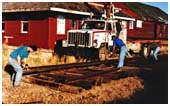
Laying 1st rail - Carl
Goddard.
|
Carl's hips were giving him more and more trouble but he refused to be slowed down by his physical
challenges. In 1999, he decided to lay track. He managed to lay his hands on a dozen rails and enough ties for 180 feet of track. Of course
with track in place Carl needed something to run on it so he acquired a track maintenance vehicle, known as a "jigger" that he can
run up and down past the front of the station. He loves nothing better than to fire it up and give people
rides.
| |
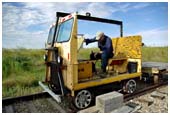
Don Volk preparing the speeder to
run - Margaret Huff.
|
Carl purchased his pride and joy, a 1913 wooden-framed caboose, at an auction in Saskatchewan in
2003. Getting the 20-ton caboose to Manyberries took a 70-ton crane at either end to lift it onto, and then off of, the special double drop
low-bed trailer that made the trip. One end of the caboose had to be rebuilt and it has been repainted inside and out.
While all of this hard work was going on, Carl and Joyce welcomed travelers and area residents alike to tour the station and enjoy rides on
the jigger. Over the years many people stayed at the Manyberries Station bed and breakfast. Included among them was Country Roads of Alberta
author Liz Bryan and photographer Karl-Heinz Raach, whose book, Kanada, won an award at a prestigious travel trade show in Berlin, Germany,
in March 2011.
| |
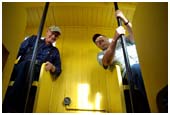
Don Volk and Bruce Huff pose in the
caboose cupola - Margaret Huff.
|
In the past few years, getting around became increasingly difficult for Carl. Eventually, he was forced to retire his canes adopt a walker.
Joyce's health has deteriorated as well.
There haven't been many paying guests at the Manyberries Station Bed and Breakfast for a couple of years, but Carl and Joyce continue to
rent out the bunkhouse to hunters every fall. The restoration of the station and caboose have pretty much been accomplished, but Carl
continued to dream. He'd like to see some of the 122-acre parcel developed for recreational vehicle camping. "A nice wash house with
bathrooms and showers," he muses. "It could be great."
"There has to be someone out there who'd like to take this on and finish the thing," he concluded with a twinkle in his eye and a
faint grimace that speaks of his regret that the guy who'll finish the project won't be him.
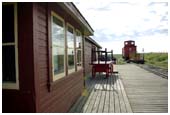
Manyberries station
platform - Margaret Huff.
|
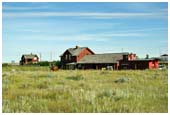
The entire complex at
Manyberries - Margaret Huff.
|
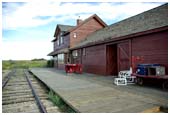
Manyberries station
platform - Margaret Huff.
|

|